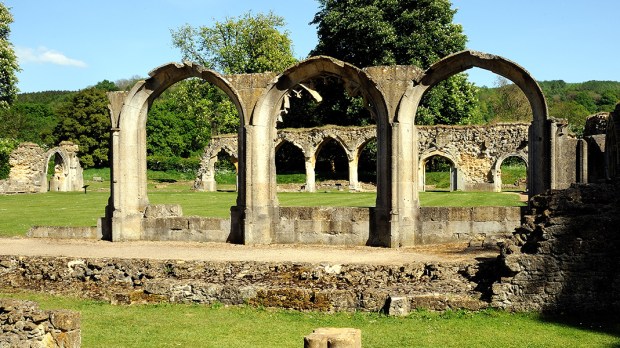Like Tintern Abbey, Hailes is a place that once was a thriving place of prayer and work that now lies in ruins. The 13th-century Cistercian abbey in Gloucestershire, England, a key pilgrimage site in the Middle Ages, was suppressed by King Henry VIII in 1539, stripped of its material wealth, and left to return to nature.
But what distinguishes Hailes from other former monasteries in England is that this place was once graced by a very special relic, which drew pilgrims from all over. Hailes, in the year 1270, received a portion of the Blood of Christ.
Hailes was founded in 1246 by Richard, the Earl of Cornwall, the younger brother of King Henry III, in thanksgiving for surviving a shipwreck. His son Edmund was in Germany in 1268, and obtained “what was believed to be a portion of the blood shed by Christ on the Cross — the Holy Blood,” explains English Heritage, which cares for over 400 historic sites in England. “The relic was thought to have come from the coronation regalia of Charlemagne, the first Holy Roman Emperor. To the medieval mind, there could not have been a better provenance, and the relic was widely accepted as authentic.”
Edmund divided the relic between a college he founded at Hertfordshire and Hailes, where it arrived on the Feast of the Holy Cross.
The abbey set about building a new east end to its church in order to properly house and display the new relic and to receive pilgrims. The renovation is believed to be modeled after Henry III’s rebuilding of Westminster Abbey. “The swelling beauty of the deep chapels eclipsed anything previously used by the Cistercians in England,” says English Heritage.
Hailes and its relic are memorialized by “The Pardoner’s Tale,” part of Geoffrey Chaucer’s Canterbury Tales:
By God’s Precious heart and by His nails
And by the blood of Christ that’s now at Hailes.
But back in the day, Hailes was the go-to place, attracting prominent people such as Margery Kempe, a 15th-century mystic. In 1417, while on her way home from the Spanish shrine of Santiago de Compostela, Kempe stopped in at Hailes and went to confession. According to English Heritage, she received forgiveness for her sins “with loud cries and tears and boisterous weeping.”
“Her devotion impressed the monks, who invited her among them for further discussion,” English Heritage says. “Quoting from the Gospel, Margery rebuked the monks for swearing, causing them ‘great wonder’ and leaving some ‘right well pleased.'”
Several miracles are attributed to the relic, including the conversion of some skeptical clerics. One of them, a priest in Shropshire who came under the influence of John Wyclif, denied that the blood was a true relic and attempted to dissuade his parishioners from making a pilgrimage to see it. The next time he celebrated Mass, the wine in the chalice boiled up, leading to a change of heart. Another priest who similarly denied the relic saw his service book start to bleed. He soon found himself on pilgrimage to Hailes.
But no miracle could stop the reforming fervor of King Henry VIII, who seemed particularly annoyed by the financial gains the monks were making due to the relic. In 1535, he and the queen traveled through western England, visiting Winchcombe Abbey, a few miles from Hailes. English Heritage relates:
According to one source, Anne Boleyn sent some of her chaplains to enquire into the ‘abomynable abuse’ of pilgrimage to Hailes. Three years later, the relic was denounced during a sermon outside St. Paul’s Cathedral in London as being nothing more than duck’s blood. Commissioners, including Latimer, who by then was Bishop of Worcester, were dispatched to Hailes to examine the relic. After pronouncing it to be not blood but an unctuous gum, they sealed it in a box and took it with them to London. In November 1538, Bishop John Hilsey of Rochester, a fierce evangelical, delivered a fiery sermon at St. Paul’s Cross in which he declared that the blood was nothing more than clarified honey colored with saffron. The shrine of the Holy Blood was stripped of its precious metal and jeweled adornment and then dismantled. Soon after, Hailes fell victim to Henry VIII’s Suppression of the Monasteries. On Christmas Eve 1539 Abbot Sagar and the community of 21 monks signed the surrender deed. The church, which for almost 200 years was home to one of the greatest relics of medieval England, was rapidly reduced to ruins.
Today, visitors can wander through the ruins and wonder at the history of the place, where pilgrims once gazed upon Christ’s blood, receiving untold spiritual benefits. English Heritage recommends it as a “great picnic spot.” Some visitors might call to mind what T.S. Eliot said about “Little Gidding,” that it is a place where “prayer has been valid.”
And some visitors might even realize that not far from here, at St. Nicholas Catholic Church, one can find and receive the Body and Blood of Christ — not a relic — in the Eucharist at Holy Mass.

